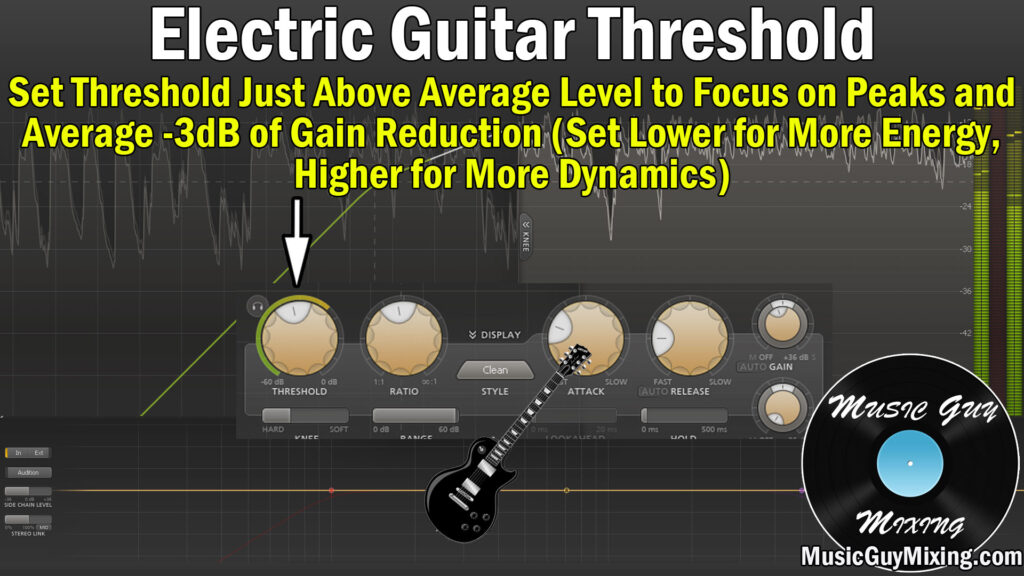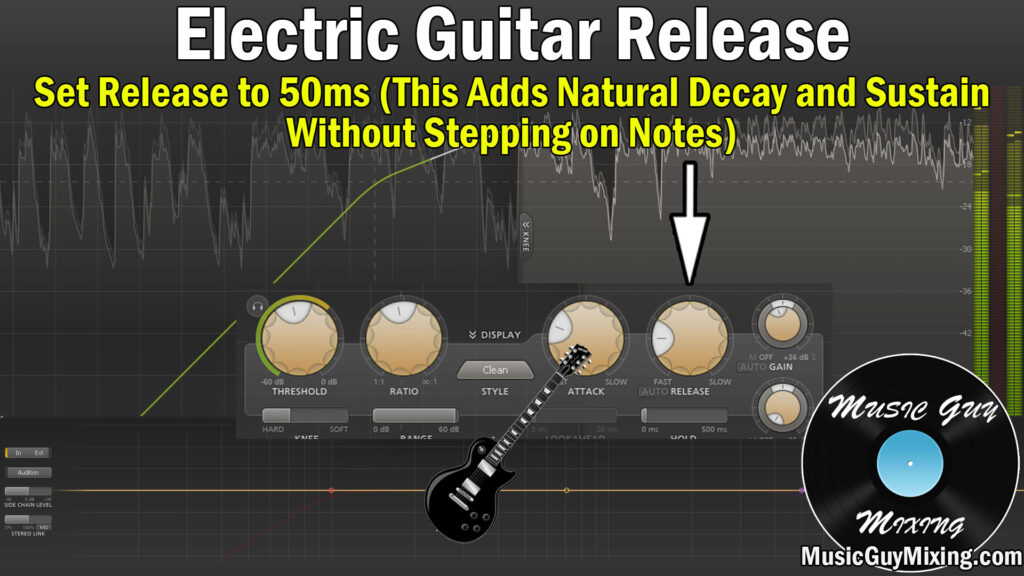Compared to compressing vocals or even compressing bass, electric guitar is generally one of the less dynamic instruments in your mix. Still, the occasional rhythm part or especially riffs and solos call for electric guitar compression to give them energy and keep them present in your mix. Use this electric guitar compression guide to give your guitar the lift it needs in your mix.
Electric Guitar Compression Guide
Let’s go through each of the typical compressor settings to identify where to set each for the best electric guitar compression.

Threshold
The compression threshold dictates the required input signal on the electric guitar before compression will begin.
For electric guitar compression, given the relative lack of dynamics, I like to set the threshold just above the average level of the performance.

A good rough starting point is to achieve around 3dB of gain reduction when the compressor is engaged. Note that this relates to the ratio of the compression itself which we’ll cover in a second.
This especially targets the peaks, kissing the average level slightly, and leaving the quietest parts untouched (raised by the makeup gain ultimately).
I prefer a relatively harder knee to strictly enforce the threshold and leave the quieter bits uncompressed.
As always, turn the threshold down if you want more energy with more of the signal compressed. Turn it up if you want to leave it more dynamic.
My general rule is when the guitar or track in general is fighting a busier mix for real estate, you want more energy over dynamics. If the guitar is more prominently featured in a sparser mix, turn the threshold up and leave it more dynamic. The same rule applies to the ratio, so let’s hit it now.
Ratio
The compression ratio works together with the threshold to determine how much of the signal gets reduced.
I like a relatively conservative ratio of 3:1 for electric guitar compression most of the time.

With a 3:1 ratio, if the threshold gets exceeded by 9dB, it gets reduced to 3. If the threshold is exceeded by 3dB, it becomes 1dB.
3:1 is on the lower to average rate of compression and I find it works well for just smoothing out the peaks of the guitar as opposed to squashing them completely. It’s about finding the sweet spot of preserving dynamics while adding energy, and 3:1 is a good place to start.
Coupled with the threshold, you want to average the aforementioned 3dB of gain reduction unless you’ve got an especially dynamic electric guitar track.
Once again if you want more energy, try raising the ratio. If you want more dynamics, dial it back.
Attack
The compressor’s attack determines how quickly the compressor engages once that threshold is exceeded.
Setting this all the way to the left, meaning instant compression, on most compressors would suffocate the audio’s transients.
The transients are the initial “bite” of the audio, or the first element of the audio we hear. Because higher frequencies travel faster (see parts of a sound wave), in the case of electric guitar it’s the sharp sound of the string itself.
As such, I like to set the attack to 3-5ms (that’s milliseconds) which seems instant, but it’s still enough to allow the bite of the string to figuratively “cut” through the mix.

This draws the listener’s attention to that electric guitar track for long enough before the compressor snaps down on the signal to get the benefits on the back end.
Release
Rather intuitively, the compression release determines how long after the signal drops below the threshold that the track takes to return to its uncompressed state.
A release time of 50ms works well on electric guitar to achieve a natural decay and sustain with minimal artifacts or stepping on the next note.

As with all of these settings, experiment to find the sweet spot for your specific track.
Don’t forget to set your output gain to match the level pre-compression to keep gain staging in mind!
One last tip – you might also try blending in some parallel compression to add some thickness to your electric guitar by way of some absolutely squashed signal.
Electric Guitar Compression Tips
- A good electric guitar compression will balance sustain and energy with dynamics.
- Begin by setting the threshold to slightly above the average level.
- Experiment with a starting ratio of 3:1. Set this higher for more energy, lower for more dynamics.
- Set attack to 3-5ms to preserve transients.
- Set release at 50ms to create a natural sustain and decay without suffocating the next note(s).
- Set your output gain to match your input gain when split testing the compressor on and off (creates a fair comparison and maintains gain staging).
